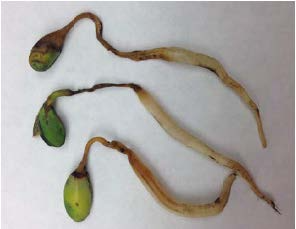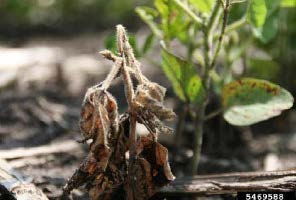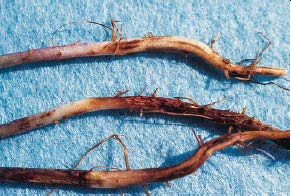- Soybean seedling diseases are often caused by fungal pathogens, which can slow germination and plant growth, and kill seedlings.
- Conditions that favor disease development are cool to warm temperatures and wet, poorly drained soils.
- Once the pathogens that cause diseases are present within the environment they cannot eliminated and must be managed to reduce yield loss.
Types of Seedling Diseases, Causal Agents, and Symptoms
The three main categories of soybean seedling diseases are seed rot, seedling mortality, and root and stem decay: Seed rot (V0-VE growth stages):
- Fungal pathogens: Pythium, Phytophthora, and Phomopsis.
- Typical symptoms: soft decay of the seed and missing seedlings in the row or poor emergence.
Seedling mortality (damping-off or seedling blight) (VE-V4 growth stages):
- Fungal pathogens: Pythium (Figure 1), Phytophthora (Figure 2), Rhizoctonia (Figure 3), and sometimes Fusarium.
- Typical symptoms: hypocotyl appears pinched and rotted. Yellowed and wilted leaves later turn brown. Leaves remain attached to the stem after plant death.
Root and lower stem decay (VE-V6 growth stages):
- Fungal pathogens: Phytophthora, Rhizoctonia, and sometimes Fusarium.
- Typical symptoms: brown to reddish-brown necrotic lesions on stem and rotted roots.

Figure 1. Pythium damping-off exhibiting a typical brownish water-soaked lesion on the hypocotyl and disintegrated secondary roots.

Figure 2. Above ground damping-off symptoms in soybean. Photo courtesy of Daren Mueller, Iowa State University,Bugwood.org.

Figure 3. Characteristic reddish lesions on the stem of soybean plants infected with Rhizoctonia.
Pathogen Identification
Identifying the specific pathogen causing disease will assist with management decisions for the field in future growing seasons, including planting resistant soybean products or using fungicide treated seed. Consider the following information for each field to help distinguish which pathogen is present:
- General soil temperatures.
- General soil moisture (saturated, wet, or dry).
- Soybean product resistance or tolerance to Phytophthora.
- Plant growth stage.
Contact your state Plant Disease Clinic for assistance with disease identification.
Distinguishing between Pythium, Phytophthora, and Rhizoctonia damping-off
Pythium
- Hypocotyl will appear rotted. Leaves of infected seedlings will turn brown before dying. Stems are soft and watery.
- Common in wet, poorly drained, compacted soils.
- More common in cooler temperatures (50-60° F).
Phytophthora
- Symptoms are very similar to Pythium infection.
- Symptoms usually appear above the soil line.
- Common in wet, poorly drained, compacted soils.
- More common in warm temperatures (80° F).
Rhizoctonia
- Localized reddish-brown lesions can be seen in the cortical layer of the main root or hypocotyl. Stems remain firm and dry.
- Symptoms usually appear below the soil line.
- Common in moist (but not saturated) soil conditions.
- Common in warm temperatures (80° F).
Management
Diseases are difficult to control once they develop. Therefore, the most inexpensive, efficient, and effective disease control measures are preventive. Remember, any factor that delays germination or seedling emergence provides increased opportunity for disease infection.
Management of soybean seedling diseases includes:
- Avoid planting in environmental conditions that promote disease (temperatures below 68° F, wet and/or compacted soils).
- Plant high quality, professionally grown seed that is disease free.
- Use fungicide seed treatments.
- Plant resistant or tolerant soybeans (Phytophthora only). A seed treatment should be used with tolerant soybean products.
- Rotations with a grass crop (corn or sorghum) for several years can help to reduce disease inoculum in the soil.
- Fungal pathogens can survive by overwintering in plant debris and in the soil; therefore, diseases may be more problematic in fields where no-till or reduced-till is practiced and in fields with high amounts of plant residue.
- Use good agricultural practices to reduce plant stress.
